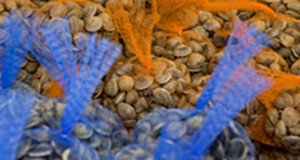Aquaculture is a growing industry in Florida, and there is particular interest in offshore marine aquaculture. While inland and coastal aquaculture (like for shellfish or ornamental fish) is managed by the Florida state agency Florida Department of Agriculture and Consumer Services (FDACS), offshore aquaculture also involves federal management agencies. However, there has been some confusion and disagreement about which federal agencies will manage and make decisions about offshore aquaculture in the United States. This document describes a recent history and current state of that discussion. This information is important for potential aquaculturists and other stakeholders to understand, and should also provide guidance to management and outreach agencies seeking to inform stakeholders about offshore aquaculture.
https://edis.ifas.ufl.edu/fa230
Tag: Aquaculture
Molluscan Shellfish Aquaculture and Production

Molluscan shellfish aquaculture provides high quality and high value seafood for human consumption, and shellfish provide environmentally beneficial ecosystem services, such as nutrient extraction and water filtration, to the environment in which they are grown. In the past five decades, global fisheries and aquaculture have grown steadily, and seafood consumption per capita has increased. Molluscan shellfish has traditionally been a major component of world aquaculture. Today, molluscs are cultured in 76 countries. This 8-page fact sheet written by Huiping Yang, Leslie N. Sturmer, and Shirley Baker describes molluscan shellfish aquaculture in the United States and worldwide and outlines molluscan shellfish aquaculture stages and methodologies.
http://edis.ifas.ufl.edu/fa191
FA168 Candidate Species for Florida Aquaculture: Pinfish, Lagodon rhomboides
FA168, a 6-page illustrated fact sheet by Cortney L. Ohs, Scott W. Grabe, Matthew A. DiMaggio, describes this marine baitfish of the Sparidae (porgy/sea bream) family which has potential for culture in the southeastern United States — general description, geographic distribution and habitat, nautral history, culture techniques, broodstock nutrition, broodstock reproduction, hatchery, nursery, growout, disease, and market. Includes references. Published by the UF Program in Fisheries and Aquatic Sciences, School of Forest Resources and Conservation, May 2010.
http://edis.ifas.ufl.edu/fa168
FA155 Candidate Species for Florida Aquaculture: Hybrid Striped Bass, Morone saxatilis x Morone chrysops
FA155, a 9-page illustrated fact sheet by Cortney L. Ohs, Christian L. Miller, and R. LeRoy Creswell, describes these crosses between striped bass and white bass, commonly called sunshine bass and palmetto bass — geographical distribution and habitat, phases of production, pond, cage, and tank production, feeding, water quality, and marketing. Includes references. Published by the UF School of Forest Resources and Conservation Program for Fisheries and Aquatic Sciences, December 2008.
http://edis.ifas.ufl.edu/FA155
FA156 Use of Vaccines in Finfish Aquaculture
FA156, an 8-page fact sheet by Roy P. E. Yanong, uses a question-and-answer format to address the topic of vaccine use in warmwater aquaculture facilities. Includes references. Published by the UF Program in Fisheries and Aquatic Sciences, School of Forest Resources and Conservation, December 2008.
http://edis.ifas.ufl.edu/FA156